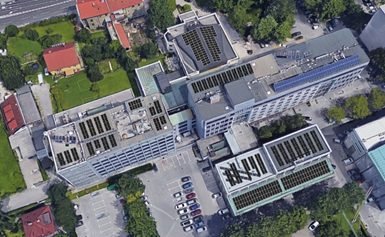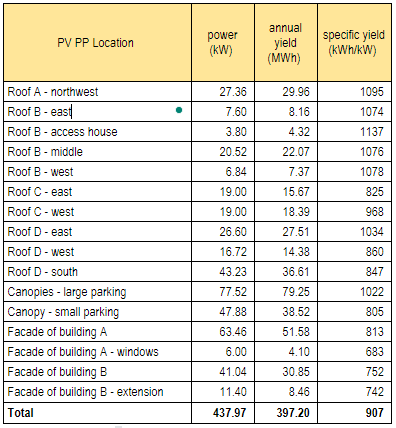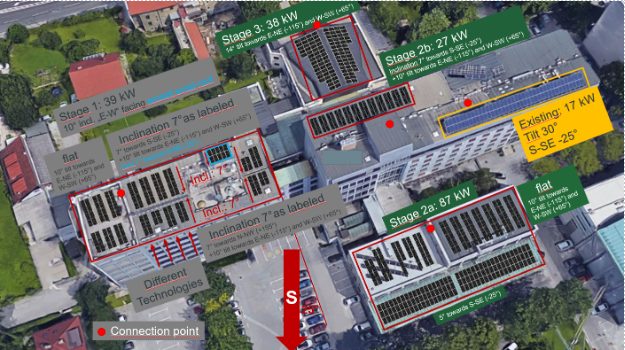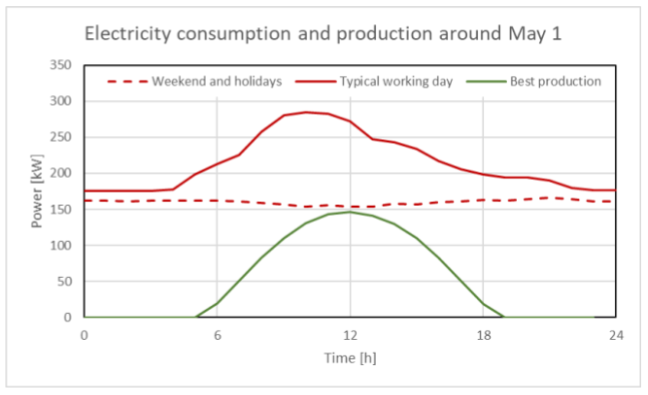The demonstrator site in Ljubljana will be set up at the Faculty of Electrical Engineering (FE), which is a member of the University of Ljubljana (UL). The members of the University of Ljubljana are spread out in many buildings across the city of Ljubljana. The Faculty of Electrical Engineering is situated at Tržaška cesta in Ljubljana and consists of four interconnected buildings with enough roof space for about 200 kW photovoltaic power plant.

There is enough space on the Faculty of Electrical Engineering’s horizontal roof for a PVPP with a capacity of around 200 kW depending on the exact PV module power. Parts of the roof are already covered with different kinds of photovoltaic panels, which are being used for research purposes. The physical location of the PVPP is on the roof of four different faculty buildings.
This is an excellent location for a PVPP due to the ample amount of sunlight that shines on the site. There is also plenty of space for additional panels on facades if needed in the future. Installing a PVPP at this location will help to reduce the University of Ljubljana’s carbon footprint and contribute to awareness of all stakeholders of the faculty on the production of electricity from renewable energy sources.
The Faculty of Electrical Engineering is the perfect place to install a PVPP due to its prominent location and its importance in educating students on renewable energy sources. Most important of all – students can see the power plant in action and learn from it directly.
In the beginning of the AURORA project, we started screening both the social readiness as well as the legal limitations. Obstacles were encountered in both fields. Discussions with students and poll results showed that students are not keen on financial investment, but their interest is rather on gathering knowledge about renewable energies. However, faculty and university employees possess greater financial resources. Nevertheless, if students were to contribute only symbolically, it would disproportionately increase management costs and create a financially imbalanced community, potentially discouraging employee participation. Additionally, such symbolic contributions would result in minimal financial gains, which may also discourage students.
We also investigated different legal possibilities of establishing an energy community. During a meeting between AURORA project managers, the Faculty of Electrical Engineering management, and a lawyer specializing in corporate law and renewable energy, it was discovered that Article 10 of the Higher Education Act, which addresses the legal capacity of the university and its members, is currently deemed unconstitutional. This article is presently the subject of a legal dispute and prohibits the formation of new legal entities by its members. Furthermore, as public institutions, the Faculty of Electrical Engineering and the University of Ljubljana require explicit approval from the Government of Slovenia to establish or co-establish any new legal entity. Consequently, neither the Faculty of Electrical Engineering nor the University of Ljubljana can currently establish new legal entities
To address and circumvent these obstacles, we have decided to create a virtual energy community specifically for students, called the Student Energy Club (ŠEK). This will allow us to address the legal and social challenges while promoting energy awareness and encouraging investment in photovoltaic power plants to achieve energy independence. The purpose of these communities is not primarily to raise funds for investments but rather to raise awareness about renewable energy sources among students and faculty members.
At the same time, to fulfil the AURORA objective to set up a PV power plant and to have a power plant for demonstration purposes for students and employees and to get real-life data of electricity production to virtually offset an individual’s carbon footprint in the AURORA app, we started the procedure to install the first stage of the Solar PV Power Plant using our internal funds. The PV power plant will offset an important amount of faculty’s electricity consumption and offset its CO2 footprint as well as reduce the virtual citizen CO2 footprint for all participants in ŠEK.
Faculty’s PV potential
We have relied on a study of all available faculty surfaces that can eventually be covered by PV panels. In the study, we included all the roofs, south-facing facades and canopies over parking places. The study included detailed shading analysis for all surfaces and was based on a 380 W PV module with dimensions of 1755 · 1004 mm2. The study on the other hand did not go into detail from a civil engineering point of view and did not include static and fire safety assessments. In total, it is possible to install 432 kW of PV panels that would produce 392 MWh of electricity annually.

PV Power Plant plan
For the purpose of the AURORA energy community, the PV power plant will be primarily installed on the rooftops of the buildings of the Faculty of Electrical Engineering within the University of Ljubljana, at the address: Trzaska cesta 25, SI-1000 Ljubljana, Slovenia. The coordinates are:
- Latitude: 46.04° N
- Longitude: 14.49° E

Production and self-consumption
Electricity demand of the faculty is usually low during weekends and holidays and over the nights because most people are at home. During working daytime hours there is an increased need for university-related operations. The base consumption of 4 MWh per day is present throughout the year, with variable increases of 1.5 to 3 MWh, depending on the circumstances. 7 days periodicity is due to the working week, and the increase in June and the first half of July is due to air conditioning. The decrease in the second half of July and August is due to the summer holidays, and the increase from October until the last week of December is due to intense study semesters and shorter days. In total, in 2021 1.9 GWh was consumed, out of which about 10% can be offset by a planned 200 kW PVPP.

A typical working hour increase corresponds very well to the predicted generation of the power plant with modules installed in a 10°east-west orientation. Detailed circumstances around May 1 are shown in Figure 16. The chart shows that with a proposed 200 kW solar system, all the generated electricity will be used on-site. In the case of an unlikely surplus, electricity will be exported to the grid and will be sold to the electricity provider at an annual power purchase agreement negotiated by the market price.

Tender
Four PV power plants on all available roofs sum up to about 200 kW, which in rough estimate is about 200 k€. The realization of project of this size requires in a public institution in Slovenia requires a public tender. We prepared the documentation for the public tender based on the Conceptual design. Due to complicated static situation, we also immediately hired a civil engineer to provide a static assessment for all four buildings.
The technical specification in the tender was written in such a way that it did not prefer a certain installer. The modules were not selected, nor was the sub construction (apart from static requirements) or the inverters.
The specific requirements were:
- Modules with efficiency above 20%
- Different inverters on different roofs
- Complete service from planning, via obtaining grid permit, to final installation and connection to the grid
- Compliance with static report
Site visit prior to public tender application was not required (because such requirement is not allowed by the law, but it was available for every applicant and very much encouraged.
The selection criterion was based on:
- Specific price of the power plan (€/W) (main criterion)
- Module efficiency (additional points)
- Module efficiency after 25 years (additional points)
The legal part of the public tender documentation was prepared by our administration as it requires law knowledge and experience.
Interest in the tender was greater than anticipated:
- 7 companies visited our premises
- 4 companies did not apply
- 4 applications were received (3 with a visit, 1 without a visit)
- 2 applications were eliminated due to non-compliance with technical requirements
Out of the two remaining companies, the contractor was selected with the lower specific price as well as with the highest efficiency and most reliable modules.
The conceptual design was not a strict requirement for the tender, and contractor could change their designs slightly to match their module size, sub construction limitations and/or provide a more optimized solution. The contractor will use glass-glass modules with TOP-Con cells that measure 1722 x 1134 mm2. They proposed a revised design, which was reviewed and approved.

Summing up all the changes and considering higher module power of 440 W, total newly installed capacity increased to 206 kW. After signature of the contract on March 8 2024, the contractor visited our premises to check the roofs again for details to provide accurate revised design. They also gathered and prepared required documentation to prepare grid permit applications, which were filed in on April 9. The contractor is now preparing detailed project documentation. After the grid connection permits will be issued, the contractor will have 45 days to finish the installation. The largest unknown currently is the time it will take to obtain the grid permit. According to contractor’s experience it could take between one to four months. To be updated as demonstrator develops.
The timeline including planning is summarized in the following table.

The whole process will be described in the public Deliverable 3.3.




